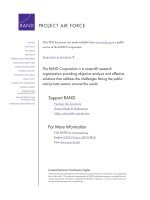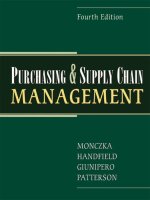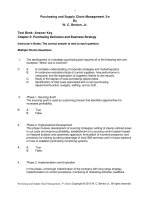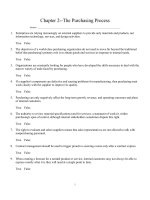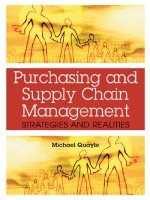Tài liệu Implementing Purchasing and Supply Chain Management - Best Practices in Market Research pptx
Bạn đang xem bản rút gọn của tài liệu. Xem và tải ngay bản đầy đủ của tài liệu tại đây (747.26 KB, 133 trang )
This document and trademark(s) contained herein are protected by law as indicated in a notice appearing
later in this work. This electronic representation of RAND intellectual property is provided for non-
commercial use only. Permission is required from RAND to reproduce, or reuse in another form, any
of our research documents for commercial use.
Limited Electronic Distribution Rights
This PDF document was made available from www.rand.org as a public
service of the RAND Corporation.
6
Jump down to document
THE ARTS
CHILD POLICY
CIVIL JUSTICE
EDUCATION
ENERGY AND ENVIRONMENT
HEALTH AND HEALTH CARE
INTERNATIONAL AFFAIRS
NATIONAL SECURITY
POPULATION AND AGING
PUBLIC SAFETY
SCIENCE AND TECHNOLOGY
SUBSTANCE ABUSE
TERRORISM AND
HOMELAND SECURITY
TRANSPORTATION AND
INFRASTRUCTURE
WORKFORCE AND WORKPLACE
The RAND Corporation is a nonprofit research
organization providing objective analysis and effective
solutions that address the challenges facing the public
and private sectors around the world.
Visit RAND at www.rand.org
Explore RAND Project AIR FORCE
View document details
For More Information
Purchase this document
Browse Books & Publications
Make a charitable contribution
Support RAND
This product is part of the RAND Corporation monograph series. RAND mono-
graphs present major research findings that address the challenges facing the public
and private sectors. All RAND monographs undergo rigorous peer review to ensure
high standards for research quality and objectivity.
Implementing Purchasing
and Supply Chain
Management
Best Practices in Market Research
Nancy Nicosia, Nancy Y. Moore
Prepared for the United States Air Force
Approved for public release; distribution unlimited
The RAND Corporation is a nonprofit research organization providing objective analysis
and effective solutions that address the challenges facing the public and private sectors
around the world. RAND’s publications do not necessarily reflect the opinions of its
research clients and sponsors.
R
®
is a registered trademark.
© Copyright 2006 RAND Corporation
All rights reserved. No part of this book may be reproduced in any form by any electronic or
mechanical means (including photocopying, recording, or information storage and retrieval)
without permission in writing from RAND.
Published 2006 by the RAND Corporation
1776 Main Street, P.O. Box 2138, Santa Monica, CA 90407-2138
1200 South Hayes Street, Arlington, VA 22202-5050
4570 Fifth Avenue, Suite 600, Pittsburgh, PA 15213-2665
RAND URL: />To order RAND documents or to obtain additional information, contact
Distribution Services: Telephone: (310) 451-7002;
Fax: (310) 451-6915; Email:
The research reported here was sponsored by the United States Air Force under Contract
F49642-01-C-0003. Further information may be obtained from the Strategic Planning
Division, Directorate of Plans, Hq USAF.
Library of Congress Cataloging-in-Publication Data
Nicosia, Nancy.
Implementing purchasing and supply chain management : best practices in market research / Nancy Nicosia,
Nancy Y. Moore.
p. cm.
“RAND Project Air Force.”
Includes bibliographical references.
ISBN-13: 978-0-8330-3985-9 (pbk. : alk. paper)
1. United States. Air Force—Procurement. 2. Marketing research—United States. I. Moore, Nancy Y.,
1947– . II. Title.
UG1123.N53 2006
358.4'162120973—dc22
2006030994
iii
Preface
To achieve targets for increased aircraft availability with decreases in costs, the Air Force is
implementing selected purchasing and supply management practices that are well-respected
in the commercial sector. e implementation is currently focused on the establishment of
commodity councils (or commodity teams)—teams of cross-functional Air Force personnel
who have responsibility for developing and implementing proactive, tailored purchasing strat-
egies for key groups of goods and services. e commodity councils must be equipped with
the market research and analysis necessary to develop and implement strategic sourcing plans.
ey must be able to collect and analyze relevant data on the industry, market, and suppliers
for their selected commodity groups. is kind of market research and analysis extends beyond
the traditional activities of Air Force procurement personnel. To address this disparity, RAND
Project AIR FORCE was asked to develop a guide to assist procurement personnel in their new
market research efforts.
is monograph is based on our review of the relevant literature and a series of interviews
with procurement professionals at commercial enterprises that are well-respected for their
sourcing practices. e monograph is intended to serve two purposes. First, it provides some
background information about market research and its relevance to commercial and Air Force
purchasing activities. e monograph assumes some basic understanding of purchasing and
supply management practices, but it also defines terms and concepts for the lay reader. Second,
the monograph provides a summary of “how-to” guidance for Air Force commodity teams
that are tasked with conducting market research. e monograph is ambitious in its goals, and
our hope is that it will achieve those goals and thus prove both interesting and useful to a broad
audience, including the reader who wants general information about market research and the
practitioner who wants to know, “How do I begin?” e goal of this research is to help the Air
Force achieve its ultimate goals—to improve aircraft availability with a reduction in costs.
is research was conducted as part of a larger study entitled “Best Practices for Purchasing
and Supply Chain Management: Developing Effective Market Research Methods and Proactive
Supply Strategies for Low Demand Items,” sponsored by the U.S. Air Force Deputy Chief of
Staff for Logistics, Installations, and Mission Support, Directorate of Transformation (USAF/
A4I) and the Deputy Assistant Secretary (Contracting) (SAF/AQC), and conducted within the
Resource Management Program of RAND Project AIR FORCE. Readers may also be inter-
ested in the following related RAND publications:
iv Implementing Purchasing and Supply Chain Management: Best Practices in Market Research
Air Force Service Procurement: Approaches for Measurement and Management, Laura H.
Baldwin, John A. Ausink, and Nancy Nicosia (MG-299-AF, 2005).
Air Force Procurement Workforce Transformation: Lessons from the Commercial Sector, John
A. Ausink, Laura H. Baldwin, and Christopher Paul (MG-214-AF, 2004).
Using a Spend Analysis to Help Identify Prospective Air Force Purchasing and Supply
Management Initiatives: Summary of Selected Findings, Nancy Y. Moore, Cynthia R.
Cook, Clifford Grammich, and Charles Lindenblatt (DB-434-AF, 2004).
Implementing Best Purchasing and Supply Management Practices: Lessons from Innovative
Commercial Firms, Nancy Y. Moore, Laura H. Baldwin, Frank Camm, and Cynthia R.
Cook (DB-334-AF, 2002).
Implementing Performance-Based Services Acquisition (PBSA): Perspectives from an Air
Logistics Center and a Product Center, John A. Ausink, Laura H. Baldwin, Sarah Hunter,
and Chad Shirley (DB-388-AF, 2002).
Federal Contract Bundling: A Framework for Making and Justifying Decisions for Purchased
Services, Laura H. Baldwin, Frank Camm, and Nancy Y. Moore (MR-1224-AF, 2001).
Performance-Based Contracting in the Air Force: A Report on Experiences in the Field, John
A. Ausink, Frank Camm, and Charles Cannon (DB-342-AF, 2001).
Strategic Sourcing: Measuring and Managing Performance, Laura H. Baldwin, Frank
Camm, and Nancy Y. Moore (DB-287-AF, 2000).
Incentives to Undertake Sourcing Studies in the Air Force, Laura H. Baldwin, Frank Camm,
Edward G. Keating, and Ellen M. Pint (DB-240-AF, 1998).
Strategic Sourcing: eory and Evidence from Economics and Business Management, Ellen
M. Pint and Laura H. Baldwin (MR-865-AF, 1997).
RAND Project AIR FORCE
RAND Project AIR FORCE (PAF), a division of the RAND Corporation, is the U.S. Air
Force’s federally funded research and development center for studies and analyses. PAF pro-
vides the Air Force with independent analyses of policy alternatives affecting the development,
employment, combat readiness, and support of current and future aerospace forces. Research
is conducted in four programs: Aerospace Force Development; Manpower, Personnel, and
Training; Resource Management; and Strategy and Doctrine.
Additional information about PAF is available on our Web site at d.
org/paf.
•
•
•
•
•
•
•
•
•
•
Contents
v
Preface iii
Figures
ix
Tables
xi
Interview Lessons
xiii
Summary
xv
Acknowledgments
xxi
Abbreviations
xxiii
CHAPTER ONE
Introduction 1
Market Research
2
What Is Market Research?
2
Benefits of Market Research
2
Where to Look for Relevant Market Research Information
3
Current Air Force Market Research
3
Approach
4
Literature Review
4
Interviews with Successful Commercial Enterprises
4
About is Monograph
5
Key Terms and Concepts
5
Organization of is Monograph
5
CHAPTER TWO
Focus Market Research Resources and Efforts Where ey Are Most Needed 9
Collect the Facts About the Enterprise
9
Understand Strategic Goals, Competencies, and Requirements
9
Analyze Spending
10
Develop (or Update) the Sourcing Strategy
10
Allocate Market Research Resources and Efforts to Maximize Rewards and Minimize Risks
16
Summary
19
Review: What to Do
19
Where to Look for Relevant Information
19
vi Implementing Purchasing and Supply Chain Management: Best Practices in Market Research
CHAPTER THREE
Analyze the Industry 21
Assess How Competitive the Industry Is and How at Affects Sourcing
22
Entry Barriers
24
e reat of Substitutes
27
e Bargaining Power of Suppliers
28
Rivalry Among Existing Suppliers
30
Bargaining Power of Buyers
33
Benchmark the Industry Standards and Norms
36
Industry Standards
36
Industry Norms
38
Analyze Price and Cost
39
Conducting a Should-Cost Analysis
39
Conducting a Total-Cost Analysis
40
Investigate the Industry’s Past and Anticipate the Future
44
Looking Back at Trends
44
Projecting the Future
44
Summary
46
Review: What to Do
46
Where to Look for Relevant Information
46
CHAPTER FOUR
Identify Potential Suppliers 47
Sources of Information
47
Supplier Database
47
Supplier Web Sites
49
Supplier Catalogs
49
Supplier Annual Reports
49
Industry Web Sites
49
Trade Registers and Directories
49
Trade Journals
49
Trade Associations
50
Phone Directories
50
Supplier Sales Personnel
50
Professional Purchasing Organizations and Other Purchasing Professionals
50
Enterprise Personnel (Corporate Knowledge)
50
Summary
51
Review: What to Do
51
Where to Look for Relevant Information
51
CHAPTER FIVE
Evaluate Potential Suppliers 53
Stage 1: Preliminary Analysis
54
Stage 2: Financial Analysis
56
Stage 3: Analyses of Performance, Cost, and Capabilities
57
Performance Analyses
57
Cost Analyses
59
Capability Analyses
60
Stage 4: Evaluation Conference Between the Buyer and the Supplier
63
Summary
63
Review: What to Do
63
Where to Look for Relevant Information
64
CHAPTER SIX
Manage the Supply Base 65
Monitor Suppliers and the Industry
65
Developing Suppliers
67
Summary
68
Review: What to Do
68
Where to Look for Relevant Information
68
CHAPTER SEVEN
Putting It All Together: Current Air Force Market Research and Next Steps 69
Current Air Force Market Research
69
Recommendations for the Air Force
70
Improve Data Availability, Quality, and Utilization
70
Provide Training for Commodity Teams
71
Ensure Management Support and Staff Buy In
71
APPENDIX
A. Interview Protocol 73
B.
e Sourcing Strategy
77
C.
Internet Sources of Information
87
D. Sources for Researching Financial Status
93
E. Supplier Evaluation Tools
95
Bibliography
105
Contents vii
Figures
ix
2.1. Portfolio Analysis 18
3.1. Factors in an Industry’s Competitive Structure
23
3.2. A TCO Analysis
42
Tables
xi
1.1. Glossary 6
2.1. Pareto Analysis
16
3.1. Entry Barriers
26
3.2. reat of Substitutes
28
3.3. Bargaining Power of Suppliers
28
3.4. Market Rivalry
31
3.5. Bargaining Power of Buyers
34
3.6. Industry Standards
36
3.7. Industry Norms
38
3.8. A Should-Cost Analysis
40
3.9. Example of a Should-Cost Buildup in Manufacturing
41
5.1. Sample Financial Indicators
56
5.2. Areas for Capability Analyses
61
B.1. Sourcing Strategy Components
78
B.2. Matrix Linking Supplier Relationship to the Operational Characteristics
of the Purchase
84
C.1. Online Sources of Information
87
D.1. Sources of Financial Data
93
D.2. Interpreting Key Financial Ratios
94
E.1. Ratings for the Illustrative Plant Survey
98
E.2. Initial Supplier Evaluation
103
Interview Lessons
Tracking Spend Comprehensively 11
Proactive Buying Policies
12
Ensuring Supply of Obsolete and Low-Demand Goods
12
e Commodity Team as the One Face to the Supplier
13
Single Sourcing for Low-Demand Items
14
Number of Suppliers and Supply Base Rationalization
14
Supporting Diversity Suppliers
15
Strategic Arrangements
16
Total Cost of Ownership and Consolidation of Contracts
43
Sharing Information with Suppliers
45
Looking Beyond First-Tier Suppliers
54
Prequalified Suppliers
55
Performance Data
58
Scorecards for Potential Suppliers
59
Supplier Attitude
62
Supplier Development
67
xiii
xv
Summary
e U.S. Air Force is adopting widely accepted commercial “best practices” to change the way
it purchases goods and services, with the goals of reducing costs and improving performance
to better support its missions. Specifically, the Air Force wants to increase aircraft availability
(i.e., the number of Air Force aircraft that are maintained and ready to fly at any time) by 20
percent over the next five years while at the same time reducing costs by 10 percent
1
—all in a
changing security environment that requires the Air Force to be ready to respond to a variety
of international and domestic threats and emergencies.
Part of the Air Force effort involves the establishment of “commodity councils” (or com-
modity teams), cross-functional teams of stakeholders who develop and implement Air Force–
wide strategies for purchasing specific categories of commodities such as computers or medical
supplies. Commodity councils will enable the Air Force to leverage its purchasing power and
manage its contracts more effectively.
Commodity teams need information and analyses in order to do their jobs effectively.
First, the commodity teams need information to help them understand their own enterprise
(i.e., the Air Force) and develop purchasing strategies that are consistent with the enterprise’s
mission, culture, strategic goals, internal capabilities, budget, etc. en, through market
research, the councils need to understand the industry related to the required good or service,
who the potential suppliers of the good or service are, how to select the best suppliers, and how
to manage the enterprise-supplier relationship. Market research is essential to assembling and
maintaining a supply base that best meets the Air Force’s needs.
is monograph provides both background material about market research and an intro-
ductory “how-to” guide. Market research should be ongoing—in that it continues beyond
initial supplier selection to supplier management and development. Clearly, however, the first
iteration will be the most time intensive.
1
ese goals are from the Fiscal Year Defense Plan (fiscal year 11) U.S. Air Force Deputy Chief of Staff for Logistics,
Installations, and Mission Support (AF/A4/7) goals (U.S. Air Force, 2005). “Stretch” goals for purchasing and supply chain
management are a 20 percent increase in aircraft availability with a 20 percent decrease in costs.
xvi Implementing Purchasing and Supply Chain Management: Best Practices in Market Research
Focus Market Research Resources and Efforts Where They Are Most Needed
e first task for the commodity teams is not a core part of market research, but it is neces-
sary before market research can be effective (pp. 9–19). e teams must understand various
aspects of the Air Force itself before looking outward at the industry and potential suppliers.
Information about the Air Force will help the commodity teams decide how to allocate costly
market research efforts. For example, the commodity teams must understand the following:
Strategic goals, competencies, and requirements:
Strategic goals—Air Force strategic goals include increasing aircraft availability at
reduced costs; in the commercial sector, a goal might be to increase market share.
Core competencies—what can or should the enterprise produce itself and what should
it buy?
Requirements—what goods and services are needed? What specifications and level of
performance are necessary to achieve the enterprise’s goals?
Spend—a spend analysis explores the total amount the enterprise spends to obtain goods
and services and analyzes expenditures by commodity, supplier, and other relevant cat-
egories. Two common tools are useful for analysis of the data and making informed deci-
sions about allocating market research resources and efforts:
Pareto analysis groups goods and services into categories based on spend and volume.
Portfolio analysis focuses on vulnerability and value, quantifying the relative risks and
rewards of each good or service and characterizing their importance to the enterprise.
Sourcing strategy—the approach developed by the enterprise to procure a good or ser-
vice. e four main elements of a sourcing strategy are:
the buying policy
the number of sources
the type of source
the nature of the enterprise-supplier relationship.
Analyze the Industry
e first step in market research is to develop an understanding of the industry pertinent to
the good or service (pp. 21–46).
2
is industry analysis touches upon factors that affect sourc-
ing: the competitiveness of an industry, industry standards and norms, and costs. It is useful
to start the market research process with this general overview of the industry and then work
toward a more detailed investigation of the factors that are most relevant. e industry analysis
will then also shape the identification, evaluation, and management of suppliers described in
later chapters.
2
Market and industry are not synonymous. A supplier from another industry may offer a substitute product that would be
in the “market.” However, we will use the term industry here to encompass an industry and its substitutes in order to avoid
confusion with the market research terminology.
•
–
–
–
•
–
–
•
–
–
–
–
Summary xvii
First, the commodity team should assess how competitive an industry is and how that
competitiveness affects sourcing. For example, if an industry report indicates that the industry
is declining (e.g., the market is shrinking), then there should be competition among suppli-
ers for remaining demand. is competition, in turn, should improve sourcing opportuni-
ties with respect to cost and other performance indicators. A declining industry may also
involve increased risk of exit. e analysis should then examine more deeply which suppliers
are most competitive and viable (i.e., those that have a limited risk of exit) and why. e analy-
sis may reveal economies of scope—production synergies for suppliers who produce two or
more related products—which are essential to lowering supplier costs and ensuring suppliers’
long-term financial health. e enterprise may then identify and evaluate suppliers keeping in
mind that those who produce multiple products may offer lower prices and may represent less
supply risk.
Second, it is important that an industry analysis “benchmark”—identify and measure—
industry standards and norms. Benchmarks are useful rules-of-thumb that can guide the
sourcing strategy and assist in evaluating suppliers. Benchmarking industry standards and
norms can touch upon standardization, production, purchasing practices, and a number of
other areas.
Finally, with respect to costs, an industry analysis must address the selling price and the
total cost of ownership. An understanding of production inputs and their prices is necessary
to construct the selling price. Total cost of ownership is more comprehensive and includes not
only the selling price, but all potential costs related to the good or service before, during, and
after the transaction.
While an analysis of the industry in its current state is useful, the factors are not static.
Looking only at the current situation leaves the enterprise vulnerable to future supply disrup-
tions, cost increases, and other hazards. It also limits the ability of the enterprise to take advan-
tage of upcoming opportunities. Analysis of historical trends, cycles, and forecasts allows the
commodity team to identify and address risks as well as opportunities.
Identify Potential Suppliers
e next step in market research is to identify and make a list of suppliers of the goods and/or
services needed (pp. 47–51).
3
If viable substitute products are available, suppliers of these prod-
ucts should be included on the list of potential suppliers.
Potential suppliers can include current suppliers, former suppliers, and new suppliers.
4
Current and former suppliers are clear candidates, with whom the buyer has previous experi-
3
is process is described for an industry with a number of suppliers, but some industries may have limited competi-
tion.
4
ere may be some cases in which all existing suppliers for a product do not meet the needs of the buyer. In these cases,
the enterprise may work with a supplier to develop the capabilities to meet the enterprise’s needs. Alternatively, the enter-
prise may also develop a new supplier—perhaps from suppliers producing similar goods or using similar technologies.
Such supplier development activities can be costly in terms of effort and resources and so are dependent on the costs and
benefits.
xviii Implementing Purchasing and Supply Chain Management: Best Practices in Market Research
ence. New suppliers have not previously contracted with the enterprise; these suppliers may be
new entrants, operate in different locations, or offer functional substitutes.
e key to supplier identification is to find and develop good sources of information
about suppliers. Some useful resources are an internal supplier database (or other internal
forms of supplier records), supplier Web sites and materials such as annual reports and cata-
logs, personnel within the enterprise and at the supplier, industry sources, trade organizations,
journals, and phone directories.
Evaluate Potential Suppliers
Potential suppliers must be evaluated to determine their suitability. Supplier evaluation is an
expensive and resource-intensive process that should be tailored to the importance of the pur-
chase (pp. 53–64). e initial stages of the evaluation process (described below) may be suf-
ficient for noncritical purchases. Supplier evaluation is also an iterative process that eliminates
unsuitable suppliers at each stage. Only qualified suppliers advance to more resource-intensive
stages of the market research process. e process proceeds as follows:
First, collect basic data on potential suppliers. is preliminary analysis should include
a brief evaluation of the following elements: management, finances, references, size, trends,
future plans, and other relevant issues (e.g., quality certification). Based on the results, elimi-
nate unqualified suppliers.
Second, conduct a financial evaluation of suppliers. Financial stability is critical because
it ensures that the supplier can meet delivery requirements, respond to changes, and meet
other demands such as sustained support of the product. Some sample indicators of a supplier’s
financial health are liquidity measures, funds management ratios, profitability measures, and
measures of long-term strength. Eliminate financially unstable suppliers.
ird, analyze the supplier’s performance, costs, and capabilities, as follows. Eliminate
suppliers who do not meet the necessary requirements:
Evaluate performance data. Use past performance data for suppliers currently or formerly
in the supply base. Use third-party data, supplier data, and supplier “scorecards” for new
or potential suppliers.
Compare the selling price and the total cost of ownership across suppliers.
Analyze capabilities relevant to the particular good or service required. e most common
capabilities assessed are quality, delivery, capacity, and cost. Other capabilities (e.g., tech-
nology) should be assessed if they are relevant to the purchase.
Finally, for critical purchases, conduct evaluation conferences between management of
the enterprise and each of the remaining suppliers if such meetings would be helpful to the
enterprise in making a final selection of the appropriate supplier(s).
•
•
•
Summary xix
Manage Suppliers
Much of the market research literature focuses on information gathering for source selection
(as well as negotiations), but market research does not end when suppliers are selected and the
contracts are signed (pp. 65–68). Commercial enterprises use market research to monitor sup-
pliers and changes in markets, ensure that current suppliers remain their best option by track-
ing performance and other factors, and recognize supplier development needs for current and
potential suppliers.
Where to Look for Relevant Market Research Information
is monograph lists numerous resources for obtaining information for market research. For
example, enterprises should have information about their own goals, capabilities, requirements,
and sourcing strategies and should have compiled information in their supplier databases on
all suppliers who currently or formerly have contracted with the enterprise. External sources—
including supplier Web sites and third-party industry observers—can provide a variety of
information about the industry in general and about specific suppliers. e commodity teams
may also need to collect some data directly from suppliers through requests for information
and site visits (i.e., primary data collection).
Next Steps for the Air Force
e Air Force has made progress toward the implementation of purchasing and supply chain
management and market research, including training at Defense Acquisition University and
Acquisition Centers of Excellence (such as Warner Robins Air Logistics Center) and provision
of online resources. But the implementation of the market research process outlined in this
monograph requires additional support from the Air Force. e overriding lessons from the
literature and interviews with commercial enterprises are relevant to ensuring the Air Force’s
success: (1) improve data availability, quality, and utilization; (2) provide training for com-
modity teams; and (3) ensure the support of top management and buy in among personnel
(pp. 69–71).
xxi
Acknowledgments
We wish to thank the purchasing professionals at the commercial firms who took time to meet
with us and teach us about their approaches to market research. Assurances of anonymity pre-
vent us from identifying them here, but this research would not have been possible without
their help.
We thank Grover Dunn (AF/A4I) for his help in shaping this research to ensure that it
addressed the correct issues and concerns. We also thank Air Force procurement personnel for
assistance in understanding current market research practices within the Air Force.
We are grateful to our RAND colleagues Mary Chenoweth, Jeremy Arkes, and Laura
Baldwin for their insights. Special thanks to David Burt and Susan Gates for their thorough
and thoughtful reviews of an earlier draft.


